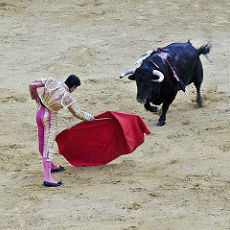Bullfighting is an ancient tradition, still practiced in Spain and Mexico. Hemingway was a real fan, writing Death in the Afternoon as a paean to his fascination. Of course, not everyone shares his approbation of the corrida, as a bullfight is called, and they have good arguments. Fan or foe, these are some books that deal with the time-honored ritual.
In Damian McNicholl's The Moment of Truth, Kathleen Boyd (based on Patricia McCormick, Mexico's first female professional bullfighter) dumps arts school and her fiancé to apprentice with a retired bullfighter to win fame and glory. Things get complicated when she falls in love and starts to question her Maestro. I found the ending a little flat, but the book is incredibly atmospheric, the characters well-drawn, and the problems Kathleen faces so real, it's a minor quibble.
Death and the Sun by Edward Lewine is a nonfiction look at one year in the life of a Spanish bullfighter, a direct descendant of those Hemingway venerated. He does not have a particularly good year with his marriage crumbling among other personal woes. However, if you're looking for an introduction to the appreciation of the corrida, this may be the book for you, as Lewine explains what makes a good bull, a good team, and a brave matador.
Novelist A.L. Kennedy has a fascination with death (including her own) and knows something of physical pain (spinal disc problems) so her editor sets her up to cover Spanish bullfighting. The result is On Bullfighting, which might be the depressive's introduction to the sport. Kennedy focuses on the bullfight and its fandom as a religion as opposed to a sport and how it influenced Federico Garcia Lorca, one of Spain's great poets and playwrights. It is also a very personal journey of trying to find a reason to go on amid life's trials. Happily, Kennedy does, her sharp wit returning to help tell this story.
The Making of Toro by Mark Sundeen is by far a much lighter book, with the author and his alter ego heading to the supposed glamor of Mexico City to witness the bullfights. Perhaps unsurprisingly nothing lives up to Sundeen's expectations, but his alter ego sees only the romance. In the end, Sundeen entirely fails to make it with the inevitable ladies, but he does become immersed in Mexican culture. Sundeen pokes fun at everything from the state of the bullrings to the instant expertizing of journalists on a specific topic, and this book will keep you at the very least smiling from beginning to end.
Got other books on this vestige of pagan Spain? Let us know in the comments.



Add a comment to: Toro! Books About Deaths in the Afternoon